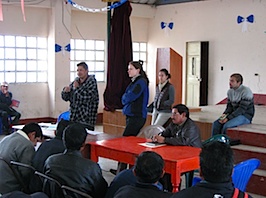 Today we gave a presentation to the assembled leaders of health committees from all over our region. We are a sort of “opening act”, a role that we get a lot. The theme: maternal mortality, and why it’s bad. Sounds pretty straightforward, but it’s something that seems to come up over and over. Though Santa Eulalia is no longer DEAD LAST in all of Guatemala for the number of mothers dying in childbirth, we’re making a run on the record again this year.
Today we gave a presentation to the assembled leaders of health committees from all over our region. We are a sort of “opening act”, a role that we get a lot. The theme: maternal mortality, and why it’s bad. Sounds pretty straightforward, but it’s something that seems to come up over and over. Though Santa Eulalia is no longer DEAD LAST in all of Guatemala for the number of mothers dying in childbirth, we’re making a run on the record again this year.
So, while preparing the lecture, Emily was researching online. On a lark, she typed “maternal death” into Wikipedia. I don’t usually think of that as a good primary source for research, but it can be a really useful tool for getting a good overview of something to kickstart your learning. This time, however, it turned up an interesting passage about half way down the page:
Another issue that is associated with maternal mortality is the distance of traveling to the nearest clinic to receive proper care. In Third World countries, as well as rural areas, this is especially true. Traveling to and back from the clinic is very difficult and costly, especially to poor families when time could have been used for working and providing incomes. Even so, the nearest clinic may not provide decent care because of the lack of proper staff and equipment such as ones in the Guatemalan highlands.[10]
I guess we’re famous. Or better said, infamous. As Emily and I put together the lecture, we realized that we needed to break it down into simple ideas that we could frame in a context that would stick with our audience. We came up with four harms that are caused by mothers dying in childbirth, and four courses of action to start reversing the trend.
The Four Harms of maternal mortality:
- Children who are unable to breastfeed have a big health disadvantage: they don’t get proper nutrition that comes from mother’s milk, nor its built-in antibodies and disease protection.
- Orphaned children have no one to love them, feed them, guard their health, or teach them. And in general, step-parents and orphanages don’t do as good a job as the birth mother.
- Husbands are left with no one to do the housework. The have to take care of all the other kids themselves, or must hire a muchacha (teenage girl) to come do all that work.
- Life is a gift from God. If we allow women to die in childbirth, we are disrespecting this gift and the God that gave it.
The shame is, the problem is largely preventable. We gave them four ideas to chew on:
- Pregnant mothers must be properly fed, to give them the strength to survive the childbirth process. They must also visit the clinic for prenatal checks, to identify any potential problems.
- Women who are in the high-risk group need to start having their babies in the hospital. Women who aren’t should have transportation available during the home birth, in case something goes wrong.
- Partners shuold engage in family planning (birth control), to space out pregnancies. A woman who gives birth every 10 or 11 months runs a MUCH greater risk of dying in the process. When a woman is over 35, she should think about stoping altogether.
- Women and girls need to receive education about their bodies, reproductive health, and healthy pregnancies.
These all seem pretty basic, and are taken for granted in the US. In Guatemala, they are the exception, not the norm. As Aurelio was translating for the half of the audience that only speaks Q’anjob’al, I caught a clever phrase. He repeated it in Spanish, in case I didn’t catch it the first time: La niña educada es la madre de desarrollo. “The educated girl is the mother of development.” Wow, that prettymuch hits the nail on the head. I hope the men were listening; in this culture, it is almost always the men who decide how much food women and children get, how often they have kids, whether or not they get to have the babies in the hospital, and even if the girls get to go to school.